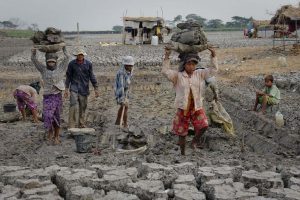As I was preparing my chapter dealing with occupational safety and health (OSH), developing the contribution on the International Labor Organization (ILO) for Human Rights in Global Health: Rights-Based Governance for a Globalizing World, I was reminded repeatedly of three vital aspects: the crying need for action; the enormous amount of effort by the ILO over the past century; and the fact that international advice and research must be taken into account at the national level if it is to be effective.
The harms to OSH are truly staggering. Every fifteen seconds, a worker dies from a work- related accident or disease. Every fifteen seconds, 153 workers have a work-related accident. Every day, 6,300 people die as a result of occupational accidents or work-related diseases – more than 2.3 million deaths per year. Some 317 million accidents occur on the job annually, many of these resulting in extended absences from work, and millions more are permanently or temporarily disabled either by accidents or by the slower effects of chemicals or infections at work. This means a loss of income and social protection for workers and their families, and a loss of human resources for the national economy.
Given these enduring harms, OSH has been one of the prime focuses of the ILO from the moment it was established, together with the League of Nations, in 1919. One of the ILO’s principal responses to these OSH challenges has been the adoption of international standards – Conventions and Recommendations – with the ILO monitoring their implementation at the national level. The ILO has adopted more than forty standards dealing specifically with OSH, with nearly half of the more than 400 ILO standards touching either directly or indirectly on health issues. Over the years, the ILO has evolved from adopting danger-specific standards – dealing with substances such as radiation and asbestos or processes such as dock work – to adopting broader standards that take a management approach to OSH. For example, there are now a number of standards on the social insurance aspect of OSH, ensuring that workers’ income lost by disease or accident is replaced and that their families are not left destitute. In this standard setting, the main approach has been technical, focusing on the obligations of governments and employers rather than the rights of workers, but the net effect is to protect the human rights of workers to a safe and healthy working environment – a right laid down in article 23 of the Universal Declaration of Human Rights.
In addition to these standards, the ILO has adopted codes of conduct, which are detailed technical guides on how to make workplaces safer and healthier. These are widely used and have had a very positive effect.
What is missing, then? These ILO practices – standard setting, ratification by governments, and ILO supervision of implementation – are lost if the ways in which businesses conduct their work, structured by their governments, do not take ILO advice into account. As evidenced by the huge numbers of occupational accidents and diseases cited at the start of this blog, many lag behind in implementing ILO standards.
There are some real obstacles to implementing these ILO policies at the national level, where lack of resources and expertise limits many countries.

International Labor Organization
Setting up and operating a national labor inspectorate costs money and talent, and many smaller countries instead prioritize wealth creation and business promotion. Prioritizing business is important, of course, but it is also short-sighted. If the workers employed by those enterprises are not given the basic protection of being safe at work, their productivity is cut, their health may be compromised, and they will be unable to make their own contribution to the economy as consumers. The social costs of throwing people into inadequate safety nets are even greater. Many governments see the immediate return of creating employment as evidence of prudent financial management, but it is only part of the picture – the easier part.
Implementing safety and health at work is also technically difficult, requiring national expertise to advance ILO policy. As an ILO official, I visited many workplaces around the world and met many members of national labor inspectorates. These inspectors were often among the most impressive national officials I encountered – people with advanced degrees in medicine, chemistry, metallurgy, and management, who spent their careers telling companies better ways of carrying out their jobs, alternative chemicals that would be just as effective and not pollute the wider environment, and how to arrange the machinery in a workspace so that workers are less likely to catch their hair in a gear wheel or lose fingers to a clumsy movement. They save thousands of lives and billions of dollars through their expertise and their forethought.
OSH is the cutting edge of the protection of human rights for public health. Most of us spend the largest part of our lives at work, whether it is driving a truck or operating a machine, or working in an office that will function better with adequate light, heat, and ventilation. As a human rights professional working at the international level, I came to understand that the human rights with the most important and immediate impact on the most people involve the right to go home from your work still having the use of your eyes, your hands, and your lungs.
Current attempts to reduce regulation of businesses repeat failed approaches of the past, favoring self-regulation by employers, and are not simply unworkable – leading to serious infringements of a little-publicized but vital part of human rights.
Lee Swepston is the former Senior Adviser on Human Rights and Human Rights Coordinator for the International Labor Organization.
Read more about the International Labor Organization’s efforts to mainstream human rights for occupational safety and health in: Human Rights in Global Health: Rights-Based Governance for a Globalizing World (2018) available from Oxford University Press or Amazon.com



